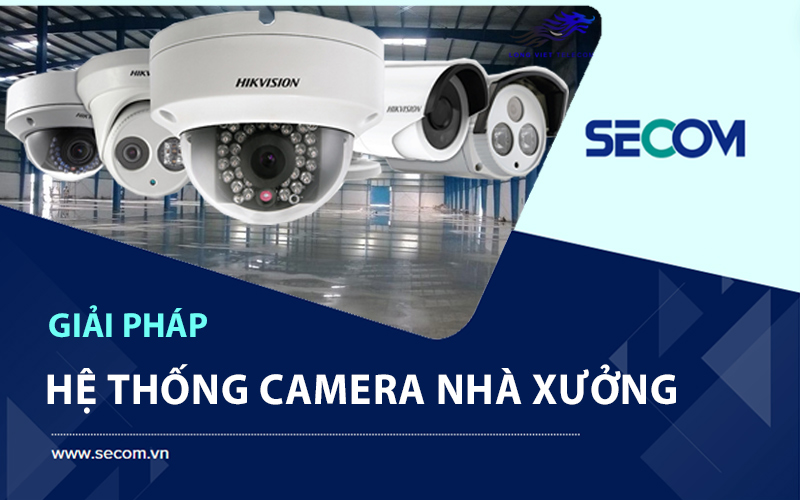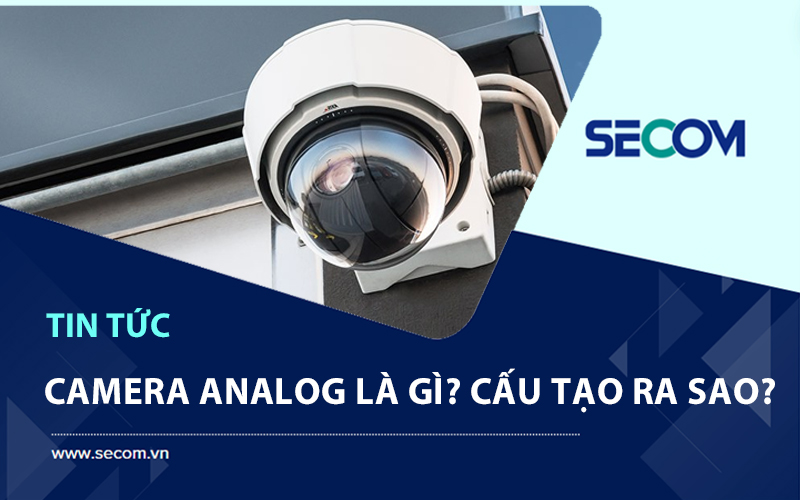- SECOM Tips
- May. 5, 2024
What is an IP Camera? Advantages, Disadvantages and Classification of IP Cameras
What is an IP Camera? Advantages, Disadvantages and Classification of IP Cameras
In today’s digital technology age, cameras act as an effective “assistant” in protecting security for families and businesses. In particular, IP cameras are increasingly popular in security monitoring thanks to their superior features compared to traditional Analog cameras. To learn in detail about what IP cameras are, the characteristics of IP cameras and the advantages and disadvantages of this camera line, please refer to the article below with SECOM Vietnam.
What is an IP camera?
To know the characteristics and structure of an IP camera, let’s first learn what an IP camera is?
IP camera is a type of camera that is controlled and used remotely via the internet. The images of this camera will be digitized, processed and encrypted from the inside. Each IP surveillance camera has its own IP address, which can be combined into a system without limitation in the number of cameras or operate independently.
The word “IP” stands for Internet Protocol, a protocol for transmitting data over a network. An IP camera (or network camera) is plugged directly into the network through the router and does not depend on a computer to work. Data from IP cameras is transmitted over the network, allowing users to observe things remotely.
General characteristics of IP surveillance cameras
As mentioned above about what an IP camera is, each device will have its own IP address, operate independently and connect directly to the Ethernet or Fast Ethernet network. IP cameras integrate CPU and display live images via IP network, allowing users to remotely observe and control devices such as computers and mobile phones without connecting to a PC.
This device also uses CCD or CMOS sensors to help users manage, observe and control remotely on their server. Currently, IP cameras are designed in a variety of designs such as camouflage, dome, infrared,… to suit the needs and space of use. In addition, this product line also offers high quality at a reasonable price, helping to satisfy users’ needs.
Structure and components of IP camera system
An IP surveillance camera system is made up of many different components depending on the specific requirements of each application. For simple IP camera systems that do not require long image storage, the basic components include:
IP cameras
IP cameras are an important part of the home surveillance camera system, used to observe and record images. This component is capable of automatically adjusting the viewing angle and focus of the image, along with integrating ambient infrared lights to improve image quality at night.
DVRs
A camera recorder is an electronic device that acts as a controller to display and review images in a surveillance camera system. The recorder will have 5 types of ports including Video Input, Video Output, Audio Input, Audio Output and RJ45 port. This is where all the signals obtained from surveillance cameras are concentrated.
Hard Drive
A specialized hard drive (HDD) for surveillance systems is responsible for storing images recorded from cameras. Currently, there are two popular types of hard drives: regular types with diverse capacities such as 250GB, 500GB, 1TB, 2TB, 3TB, 4TB and specialized types for surveillance systems that run continuously 24/7, helping to store data. data stably.
Wire
The camera’s power cord is used to provide power to the camera, so choosing the appropriate power cord will ensure the camera operates stably, effectively and safely. The voltage of the power cord can vary depending on the camera’s requirements, for example from 12V-2Ah.
Other integrated components
In addition to the basic components mentioned above, IP cameras are also integrated with many other convenient features such as dustproof, waterproof, for outdoor use, microphone and speaker for recording and audio playback, port LAN, antenna and memory card to meet diverse user needs.
Operating principle of IP camera system
After understanding the concept of what an IP camera is, the operating principle of this online monitoring system is also something that many users are interested in. IP camera systems work by transmitting digital video over connections such as ethernet, USB or WiFi instead of transmitting it through a cable to a monitor or DVR. The necessary hardware to transmit image data over the network is built into the IP camera. Each IP camera is capable of recording video like any digital camera and compressing the data, then transmitting them over the network.
To use IP camera technology, the only thing you need is a network system (internal or internet). If you use multiple IP cameras, you can still monitor them all easily because each camera has its own built-in control interface and storage method. To centrally manage all cameras, you can use an NVR (Network Video Recorder). In particular, NVR is a program that can store video from IP cameras and allow viewing of multiple cameras at the same time, similar to DVR (Digital Video Recorder).
What are the advantages and disadvantages of IP cameras?
In addition to the concept of what an IP camera is, the advantages and disadvantages of IP cameras are factors that need to be carefully considered when choosing a security monitoring solution for a business or home model. Here are some strengths and limitations of IP cameras:
Advantage
IP cameras are increasingly popular in security monitoring solutions thanks to their many outstanding advantages. Below are the highlights that make IP cameras attractive in the eyes of users:
- Modern hardware system: IP cameras are equipped with advanced hardware, completely eliminating bulky and outdated parts such as analog video recorders. Instead, the system uses powerful NVR software, which helps optimize performance and enhance data storage capacity.
- High resolution: IP cameras provide users with sharp, vivid images and videos with high resolution. By using digital signals to convert video into data streams, IP cameras ensure high quality images and videos.
- Convenient remote viewing ability: Thanks to an internet connection, you can easily view live images and videos from IP cameras anytime, anywhere, on any mobile device such as smartphones, tablets, laptops . This helps you effectively track and monitor security for your home, office, and business, anywhere.
- Simple installation: The IP camera installation process is simple, quick and easy compared to traditional cameras. You don’t need to do complicated wiring or connect to bulky video recorders, saving time and construction costs.
Defect
Although possessing many outstanding advantages, IP cameras also have certain disadvantages that users need to consider before choosing to use:
- High cost: Compared to conventional products, IP cameras have a higher price, especially those with high resolution and integrated with many smart features.
- Requires a stable Internet connection: Because the camera operates on an internet platform, the quality of images and videos depends greatly on the stability of the network connection. If the internet network is often interrupted or has slow speed, the camera image will be blurry, noisy or lagging, affecting the effectiveness of monitoring.
- Risk of cyber attack: IP camera systems can be vulnerable to cyber attacks if not carefully secured. Using weak passwords or not regularly updating software can create opportunities for hackers to penetrate the system, steal image data or even control the camera remotely.
Classification of IP cameras
Currently, the IP camera market is extremely diverse with many different models and types, meeting the diverse monitoring needs of users. However, in general, IP cameras can be classified into 3 main types:
Wireless IP camera equipment
Wireless IP cameras, also known as WiFi cameras, are a popular device that many people trust thanks to its convenience. The highlight of this camera is that the installation is extremely quick, simple and easy. You just need to place the camera in the location you want to monitor and connect to Wi-Fi to use immediately. In addition, this product line has a compact design so it can be installed in any location without worrying about taking up space. At the same time, transportation also becomes more convenient and there are fewer product failures.
Wired IP camera equipment
Unlike wireless IP cameras, this product line operates by using network cables or fiber optic cables then connecting to the network and camera via Hub, Switch, … to be accessible and usable. . The highlight of wired IP cameras is that you do not need to record, just determine the IP of each camera and access it directly. At the same time, the installation is also simple and convenient, just connect to the ADSL router via network cable and you can use it immediately.
Camera device with microphone
This type of camera has a built-in recording microphone, integrating both mic and speaker to make two-way conversations more convenient. In addition to monitoring, recording and observing, IP cameras with mics also record sounds around the installation site. This camera is a perfect combination of image and sound technology, allowing users to observe and monitor every event that occurs realistically, just connecting to the internet.
Top IP camera models commonly used today
What is an IP camera and what camera models are commonly used today are issues that many people are interested in when looking for effective security protection solutions for homes, offices and businesses. Choosing the right IP camera will help you monitor all activities safely and effectively. Below is a list of some commonly used IP camera models today:
- EZVIZ C6N Wifi IP Camera: This is one of the popular wifi IP camera models, integrated with many smart features and capable of 360-degree observation.
- Imou Bullet 2C Plus Wifi IP Camera: This wifi IP camera model has a sturdy design, is waterproof and supports convenient wireless connection.
- Dahua IPC-HDBW2231M Wifi IP Camera: Highly appreciated for its sharp image quality and ability to observe in low light conditions.
- Hikvision DS-2CD2145FWD-I: A quality IP camera model from the famous brand Hikvision, with high resolution and quality recording capabilities.
- Aiwa Japan 2.0MP AM-IPD2M IP camera: Another IP camera option with high resolution and wide viewing capabilities, providing sharp, quality images.
What type of network does IP cameras use?
Understanding the concept of what an IP camera is will help you easily choose the appropriate type of network connection. IP smart camera systems can operate on many different types of networks, the most popular are the following three types:
- Wired network: Connect directly to a modem or broadband router via Ethernet cable (RJ45, CAT5, CAT6). This is the fastest and safest way to connect to eliminate the risk of signal interference and information disclosure.
- Wireless network: IP cameras use a WiFi router to transmit data to and from a wired modem. Wireless networks have slower data transmission speeds than wired networks and are at higher risk of unauthorized access. However, using strong encryption and network customization can minimize this risk.
- Cellular network: IP cameras can use cellular connections to transmit data. Although data transfer speeds are typically slower than WiFi, mobile networks are more secure and do not require LAN settings. However, these types of cameras are often more expensive.
Should I install an IP camera system or not?
In addition to understanding what an IP camera is, many users also wonder whether they should install an IP camera system or not. The answer is yes! Installing an IP camera system brings many benefits and is an effective security solution for every home, agency, office, and company. Here are some reasons you cannot ignore installing IP cameras:
- IP cameras eliminate all old faulty hardware, instead using powerful NVR software, which helps manage data and images effectively.
- The IP camera line delivers extremely clear HD images with high resolution from 720p, 1080p, compared to PAL, CIF, NTSC standard versions on Analog Cameras. This helps the device record every moment and convert the video into a digital stream before transmitting the signal.
- IP camera equipment allows simple and easy remote observation and control. You can rest assured about the safety of your home, even when you go on business or pleasure trips.
Note when installing IP surveillance cameras
Installing IP cameras is an effective solution to protect family and property security. However, to ensure the camera system operates effectively and safely, you need to pay attention to the following important issues:
- Choose a reputable installation unit: Choose a reputable and professional installation unit to ensure the construction work is done quickly, safely and effectively. You need to follow the installation process from start to finish and request instructions on how to use it and change your password login information.
- Check the installation location: Make sure to choose an installation location so that the camera can observe every corner of the area to be monitored. For infrared IP cameras installed outdoors, you should choose a location that is resistant to water, dust and high temperatures.
- Ensure stable network source: For wifi IP cameras, it is necessary to ensure fast and stable network speed to avoid affecting image quality and video transmission speed. With wired cameras, use good transmission cables to ensure the system operates smoothly and with quality.
SECOM Vietnam – Consulting and installation of reputable camera systems
If you are looking for a reputable and quality unit to advise and install surveillance camera systems for projects or private homes, SECOM Vietnam is a suggestion that you should not ignore. As a subsidiary of Japan’s SECOM Group (the world’s leading security corporation with more than 50 years of experience), SECOM Vietnam is proud to be trusted by major brands such as Highlands Coffee, Hyundai Vietnam, etc. .. trust and choose.
When using the IP security camera installation service at SECOM Vietnam, you will receive:
- SECOM Vietnam provides consulting and installation services for top quality and reputable surveillance camera systems in the market.
- SECOM Vietnam’s team of experienced consultants will survey needs and installation locations to advise on the most suitable camera solution for users, ensuring optimal monitoring efficiency and cost savings.
- Our team of technicians are strictly and methodically trained, have many years of experience in the field of camera installation, ensuring quick, accurate construction and can complete the installation process within 24 hours. hours from receipt of order.
- SECOM Vietnam provides camera services with reasonable and competitive prices in the market.
- We apply genuine warranty policy for all installed camera products. Customers are supported with periodic maintenance and repairs during the warranty period.
With the benefits and reputation from SECOM Vietnam, you can rest assured installing a surveillance camera system for your project or home. If you need advice or installation of an online monitoring system, please contact us via hotline for the earliest support.
In short, understanding what an IP camera is will help you choose the type of camera that suits your specific needs and requirements. Hopefully the information in the article will be useful to individuals and businesses who intend to install surveillance camera systems for their homes or buildings.
























